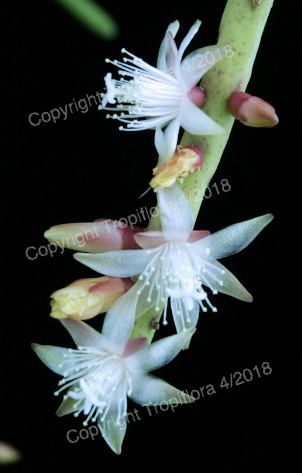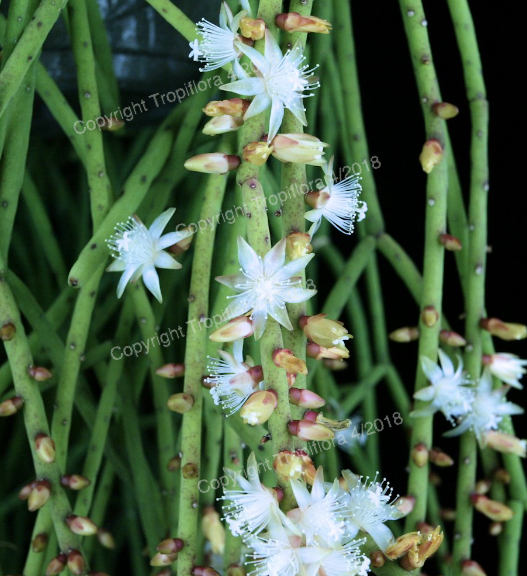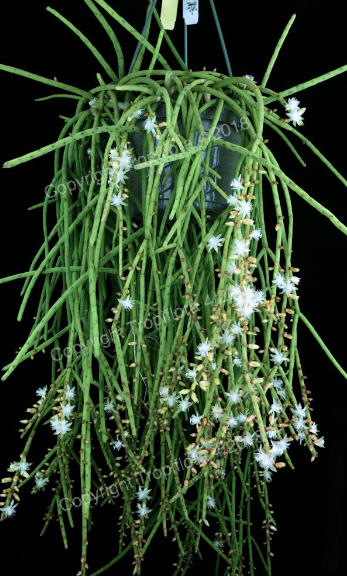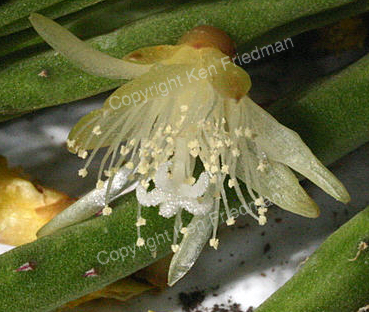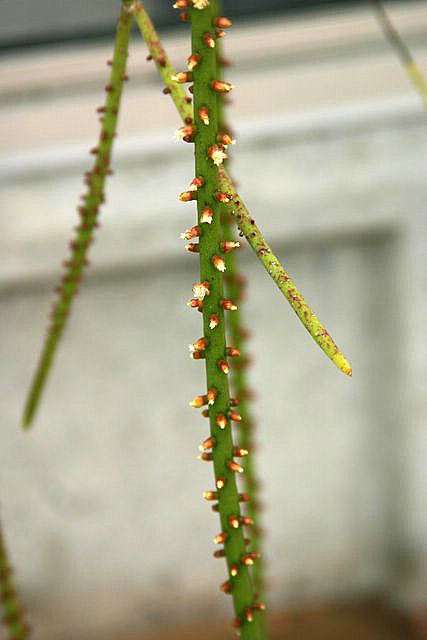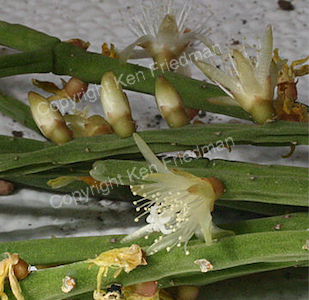| Rhipsalis lindbergiana K.Schumann in Martius, Fl. Bras. 4(2): 271. 1890 | |
| Desc from B&R 1923
Three photos copyright and courtesy of Tropiflora Nursery, Sarasota, Fla., April 2018. DISTRIBUTION. Brazil (E Pernambuco, Sergipe, E Bahia, Minas Gerais, Espirito Santo, Rio de Janeiro, E Sao Paulo): epiphyte in high restinga, Atlantic, brejo and caatinga-agreste forest, near sea level to at least 900 m altitude. Notes from Bradleya 13 (1995): This species is difficult to distinguish from R. baccifera in the herbarium, but quite distinct as a living plant, its stem-segments not being regularly differentiated into long extension shoots and much shorter secondary segments, their indeterminate growth terminating without the formation of a composite areole. Unlike R. baccifera, the perianth of its flower is longer than the pericarpel and its fruits are generally smaller. Also, its stems are mostly thicker, becoming longitudinally ridged when dried for the herbarium. An exceptionally thick-stemmed form was described by Lofgren (1918) as R. densiareolata, but this appears to be connected to typical R. lindbergiana by intermediates and was soon synonymized by Britton & Rose (1923). Although it has usually been misidentified as R. baccifera, this species is in fact the commonest Rhipsalis in and around the city of Rio de Janeiro and is particularly abundant in the Jardim Botanico, where it is sympatric with R. teres. From there it ranges northwards to at least Pernambuco, while its western limit appears to be close to the border between the states of Rio de Janeiro and Sao Paulo.
Desc from Hunt 2006. Body pendent up to 4m or more, forming a dense mass of closely adjacent branches, light grey green to dark green; branch segments arising subacrotonically in groups of 1-5, all of indeterminate growth and lacking composite terminal areole, up to 60-90cm x 3-6 (-12)mm, marked with spirals of minute scales; areoles apparent only after flowering, with sparse wool and minute bristles; flowers lateral from erumprnt buds, up to 9mm diam.; tepals 5-9, greenish white; stigma 3-4, 1mm; pericarp green to reddish; fruit 3-5 x 2.5-4mm, white or pink Rhipsalis lindbergiana K.Schumann in Martius, Fl. Bras. 4(2): 271. 1890.
Our plate L111 (habit and analysis)
Rhipsalis cassytha G. v. Beck, Itin. princ. S. – Coburg. t. II. 13. non Gartn.
Habitat in the Province of Rio de Janeiro near the metropolis: Gaudichaud n. 913, Wawra n. 509, Peckolt, de Neves- Armond; on Mount Corcovado: Riedel; at a place, by no means accurate in the same province: Widgren n. 84 Observation I. The plant that G. v. Beck falsely linked to Rh. cassyta Gartn.differs from all species in the genus with tubular joints by having grooves evident between the areoles. Flowers are distinguished from the former by being small and stigmata very small and not at all spreading. It is held that the grooved joints place it intermediate between Angulatas and Teretes, with which it largely agrees rather than with the former. Observation II. This species is named after the honourable A G Lindberg etc etc.
|
